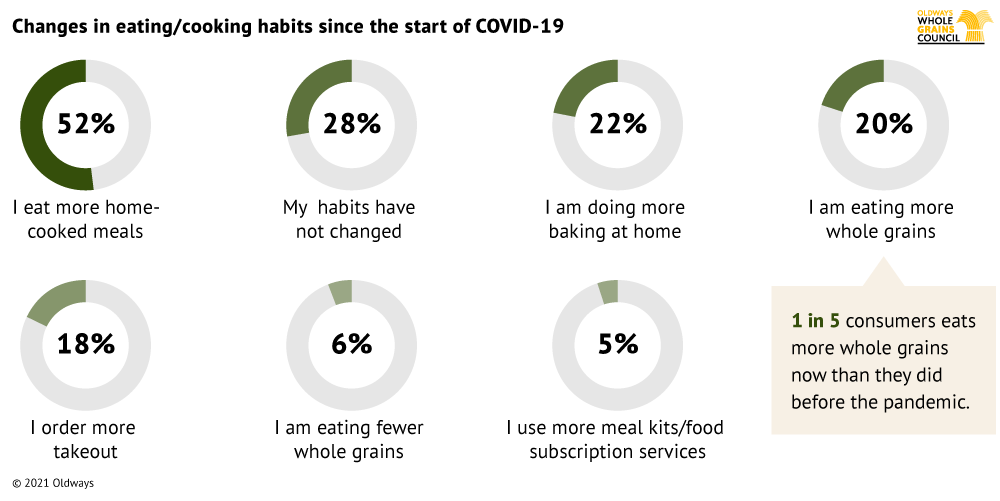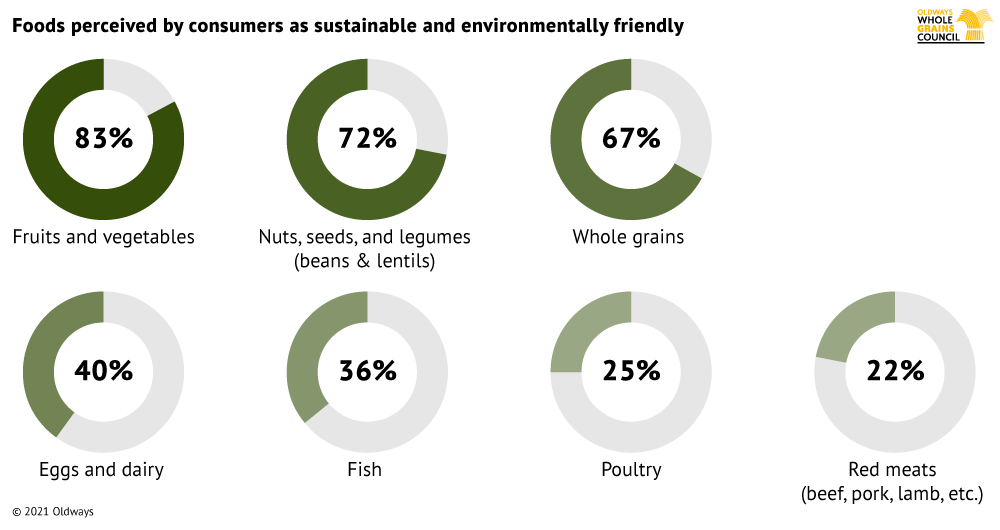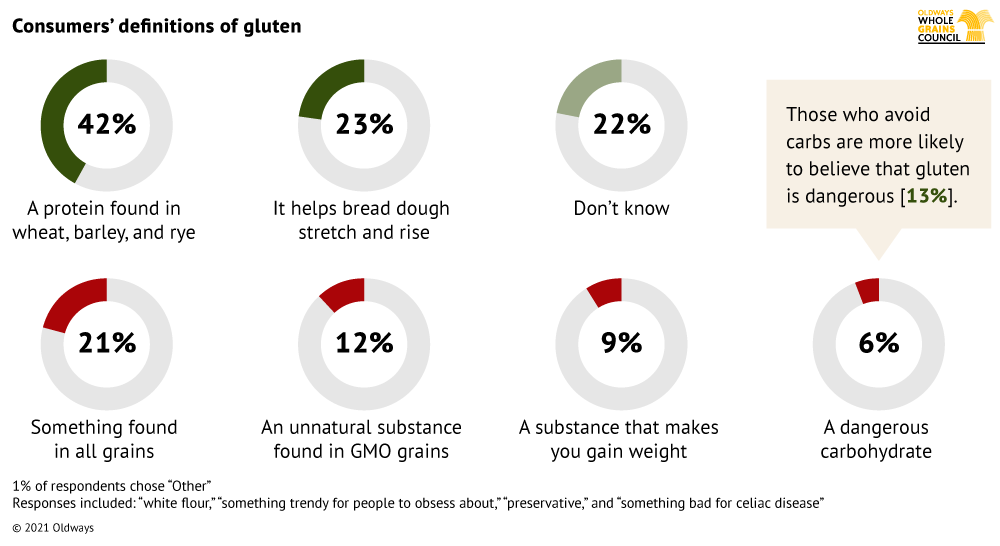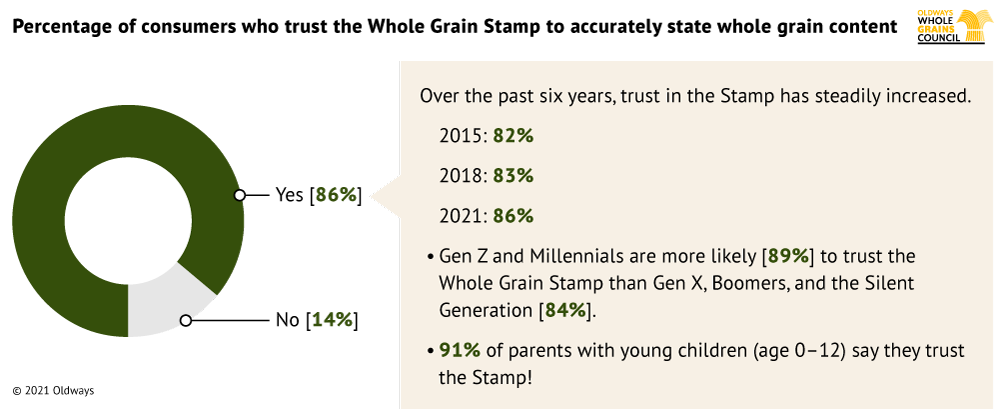Share This
Drumroll, please! The results of the Whole Grains Council’s 2021 Whole Grains Consumer Insights Survey are in and we’ve got some fascinating new statistics for you to chew on.
Did you know that consumption of whole grains has risen because of the pandemic? Or that the number of consumers who choose whole grains for their environmental benefits is on the rise? As a whole grain lover, it’s not hard to believe that more consumers view the flavor of whole grains as a benefit than see it as a barrier, but you might be surprised to learn that this is the first time we’ve seen those results – a sign that more people are embracing the taste of whole grains than ever before.
We suggest reading through our full report which explores consumers food habits, knowledge and attitudes toward whole grains, and recognition and trust in the Whole Grain Stamp. We ask why and how often people choose whole grains, which grains they are familiar with, and when and where they are most likely to consume whole grains. We ask how the pandemic has impacted food habits and how considerations about the environment are influencing the way people approach food. We include questions about ancient grains, sprouted grains, and gluten to get a better sense of how familiar and knowledgeable people are about the grain landscape. Finally, we take a deep dive into whole grain labeling – what people want to see on packages, what gives them confidence in the products they are buying, and how they use the Whole Grain Stamp when making purchasing decisions.
Here are six key findings from our survey report:
1. Whole Grain Consumption Is on the Rise
Since 2005, the Dietary Guidelines for Americans have encouraged all of us to make at least half our grains whole. According to our survey data, 59% of Americans are meeting this goal, with 26% of consumers telling us they nearly always choose whole grains whenever they are available. Additionally, more than half of consumers tell us they have increased their whole grain consumption in the past five years.
While health remains the leading reason (82%) for choosing whole grains, it’s not the only one. Today, more people consider the flavor of whole grains to be a benefit (38%) than a barrier (33%), and the percentage of those who cite taste as a barrier has fallen significantly since our last survey. In 2021, 33% say taste is a barrier, compared with 42% in 2018. Of those who say they nearly always choose whole grains, 45% see taste as a benefit and only 18% see it as a barrier, suggesting that the more exposure you have to whole grains, the more you come to appreciate their nuttier, more robust flavors.
Despite the media hype around low-carb and grain-free fad diets, the reality is that 95% of consumers tell us their whole grain consumption has either increased or is holding steady compared with five years ago. Interestingly, while we often assume that low-carb dieters have lower whole grain consumption, those survey respondents who say they avoid carbs are more likely to also say they look for whole grains when shopping. Those who say they avoid carbs are also more likely to say they nearly always choose whole grain options and more likely to tell us their whole grain intake has increased in the last five years. This may indicate that people are differentiating based on the nutritional quality of different carbohydrate sources, and gravitating toward high-quality carbs, like whole grains.
2. People are Eating More Whole Grains Because of the Pandemic
Our survey data show that the vast majority of consumers (88%) are most likely to consume whole grains when eating at home. With half of American consumers reporting that they are eating more home-cooked meals as a result of the pandemic, it may be no surprise that 1 in 5 consumers tells us they are also eating more whole grains now than they did before the pandemic.
3. Increasingly, Sustainability Is a Motivation for Choosing Whole Grains
Two-thirds of consumers consider whole grains to be sustainable and environmentally friendly. In 2018, when we asked if sustainability was one of the reasons people choose whole grains, just 12% of consumers said yes. Today, 19% say sustainability is a factor in choosing whole grains, and among young consumers (Gen Z and Millennials) this is an even stronger motivator, with 26% citing sustainability in their decision making.
4. There Continues to Be a lot of Confusion about Gluten
About half of American consumers have some idea what gluten is, but very few (only 7%) can fully define it correctly. Although one quarter of consumers told us they have cut back on gluten, 92% of people say they eat gluten some or all of the time, meaning that they are not following a true gluten-free diet. Only 1.84% of consumers told us they avoid gluten entirely due to a medical diagnosis, which lines up with the estimated prevalence of celiac disease in the general population.
5. Third-Party Packaging Symbols Like the Whole Grain Stamp Boost Consumer Confidence and Provide Important Information to Consumers
About two-thirds of consumers say seeing third-party labeling on foods gives them more confidence in the products they are buying. Our survey also found that a significant majority of consumers (70%) wish information about the whole grain content of products was included on product packaging. The Whole Grain Stamp provides this whole grain content information to consumers, making it easy to identify and compare whole grain products when shopping, while also providing the peace-of-mind that third-party labeling offers consumers.
6. More People Than Ever Say They Trust the Whole Grain Stamp
Trust in the Whole Grain Stamp has increased steadily over the past six years, with 86% of all consumers today saying they trust the Whole Grain Stamp, 89% percent of younger consumers saying they trust it, and 91% of parents with young children telling us they trust it. Three out of four consumers say they would use the Whole Grain Stamp as part of their purchasing decision, and most consumers say they would be skeptical of any whole grain claims made on a product that did not use the Whole Grain Stamp.
We encourage you to read the full report and let us know which statistics stand out the most to you by commenting below. (Caroline)
A press release for the 2021 Whole Grains Consumer Insights Survey is also available for members of the media.








Comments
Add a Comment